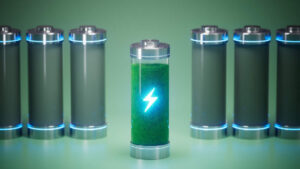Has the time come for silicon anode batteries?

Pic: Getty Images
Graphite has served as the stalwart anode material for much of the early production phase of the Li-ion battery chemistry, but developers are now turning to silicon’s unique characteristics to meet the high energy demands of the electric vehicle market.
For the next generation of lithium-ion batteries, the industry believe silicon is a promising anode material based on its ability to increase battery capacity, decrease charging times, and lower costs.
It’s a performance-enhancement trifecta that has several battery manufacturers scrambling to bring the technology to volume-production scale.
The application of silicon solutions was a hot topic at the Battery Day hosted by US electric vehicle and battery storage titan, Tesla, in 2020 who said at the time silicon would dominate the battery market over the next five to seven years and revealed plans to leverage silicon anode technology as part of its own goal of manufacturing lithium-ion batteries internally.
Since then, General Motors has announced a joint research and development agreement to study the potential use of silicon nanotechnology in its Ultium battery cells, Porsche is researching the use of silicon in their future EV batteries, and Mercedes-Benz says it will use silicon anodes in its upcoming electric G-Class SUV.
Cracking the ‘silicon code’
But there’s a catch.
Silicon tends to balloon between up to 300% in volume on each charge, causing stress and strain on the silicon particles and eventually leading the anode to break apart.
Over time, the battery performance of iPhones, computers and many other products using lithium-silicon technology drops off due to breakage of bonds, chemical linkages and the mechanical integrity of the anode.
As a result, more and more companies are working to perfect the materials and manufacturing processes that enable silicon-anode performance, while researching effective ways to control swelling and overcoming expansion issues.
AnteoTech’s solution
Brisbane-based company AnteoTech (ASX:ADO) is developing additives and advanced binder technology to boost the performance of silicon containing anodes.
Its AnteoX technology has been recognised as an emerging leader within the battery manufacturing and battery storage space after winning the Renewable Energy Award and the Australian Technologies Competition in December 2022.
According to ADO, AnteoX is a powerful additive that reinforces battery binders and helps maximise the performance of silicon containing anodes through increasing capacity, extending cycle life, thus enabling lighter and more compact high energy lithium-ion batteries to be manufactured.
The company entered into a non-binding MoU with NYSE-listed and leading binder company Trinseo Europe GmbH at the end of February to develop a program which incorporates the combination of AnteoX with Trinseo’s Voltabond binder for a clear path to market.
As more silicon is added to the anodes, more advanced binder solutions are needed to improve the effectiveness and efficiency of the anode with AnteoX being one such solution.
“From that perspective, Trinseo are looking at us as a product for today and obviously for the future,” AnteoTech managing director David Radford told Stockhead.
NOW READ: AnteoTech teams up with Trinseo for battery binding tech
Wyon MOU
At the other end of the battery ecosystem, AnteoTech is working with Swiss private company, Wyon AG, to drive the development and production anodes for the use in their customised, rechargeable miniature and micro batteries.
The partnership is expected to enable the commercialisation of AnteoTech’s proprietary silicon anode and work towards creating an effective supply chain of joint product offering.
Wyon’s small-sized batteries are designed to power a wide range of portable medical devices, including cochlear implants, hearing aids, insulin pumps, and pacemakers.
With the ability to be recharged and used multiple times, Radford said these rechargeable miniature and micro batteries have transformed the field of medical technology.
Battery ecosystem getting bigger and bigger
“There’s a huge market developing because there’s greater awareness around the speed and the access of this technology,” he told Stockhead this week.
“Everything we are hearing from our Advisory Board and from technical conferences that we attend suggest that have some very novel and interesting technologies.
“I think the fact that we’ve been able to get a partner such as Wyon in a short period of time shows us that what we have is unique and of demand.”
NOW READ: Australia’ pipeline of battery energy storage projects now the largest after China
‘Time is of the essence’
While China currently leads the world in downstream processing of battery raw materials, countries like the US is looking to change that with its Inflation Reduction Act.
Here in Australia, Federal Minister for Science and Industry Ed Husic recently announced the consultation for the country’s first National Battery Strategy as the market for next-generation batteries looks to grow 10-fold over the next decade.
“This is a once in a lifetime opportunity and speed is of the essence,” Radford said.
“The production of high silicon anodes with IP and the use of the raw materials in Australia is a fantastic opportunity and there are multiple ways to look at this.
“If you look at the part of the ecosystem within which we operate, which is high silicon anodes, down the track we could create a partnership with one of these Australian silicon companies, to buy their processed raw materials and produce the anodes in Australia and ship them offshore,” Radford explained.
“If the government wants to support it, we are delighted to be part of it but you don’t have to do all of the steps to produce a battery to be adding a lot of value to the economy – I hope we don’t get bogged down in saying we have to have the whole ecosystem here because that is going to take an awful long time.”
Related Topics
UNLOCK INSIGHTS
Discover the untold stories of emerging ASX stocks.
Daily news and expert analysis, it's free to subscribe.
By proceeding, you confirm you understand that we handle personal information in accordance with our Privacy Policy.








